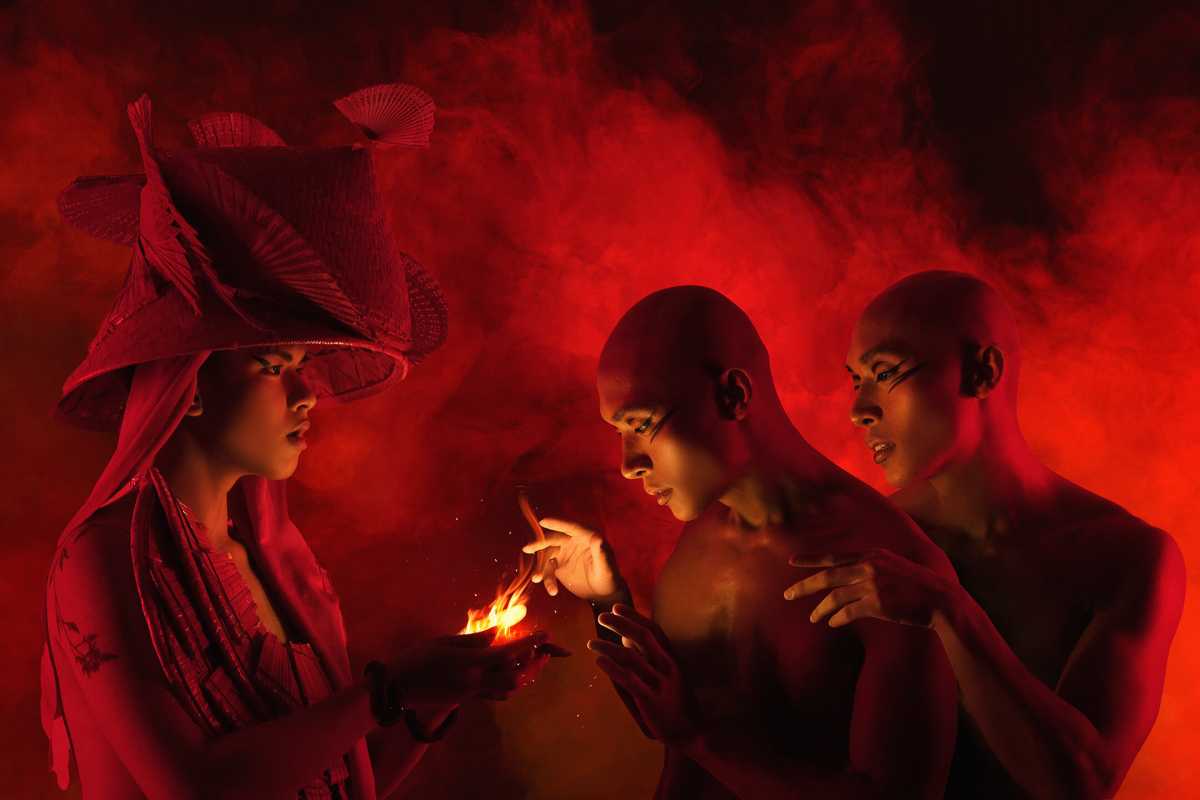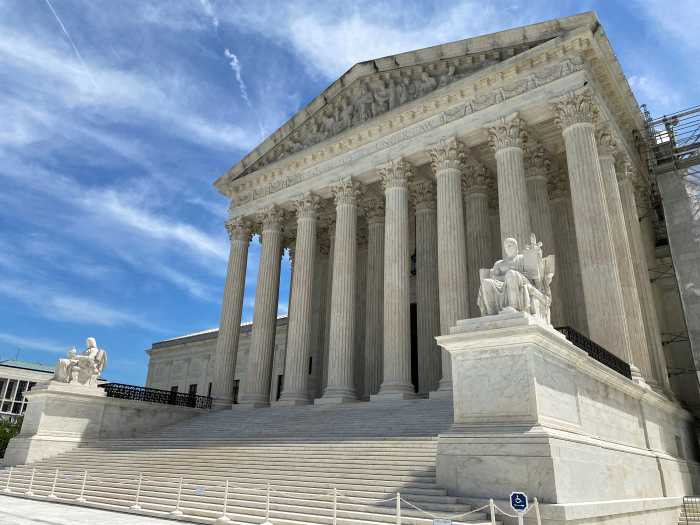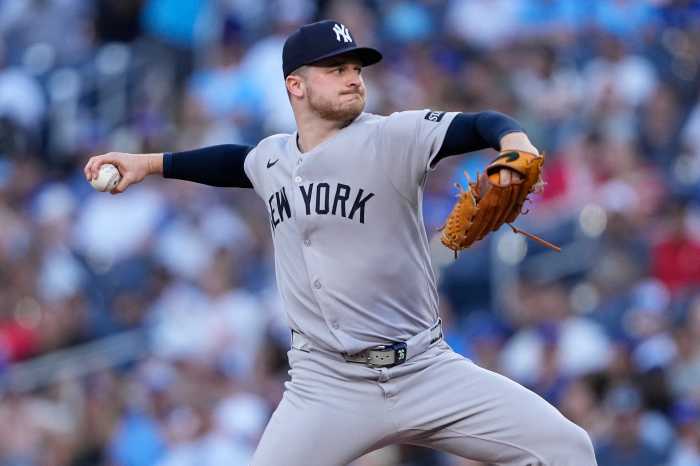On a cold rainy night, a white room in Jackson Heights is warm with the smells of lumpia rolls, palabok in its creamy golden sauce, and pancit noodles, all Filipino cuisine. A series of portraits stand in the center. They feature Filipino/a/x activists, social justice icons, and drag artists, all positioned in a haze of red, including 2015 Miss Universe Pia Wurtzbach and Drag Race Philippines Season 1 runner-up Marina Summers. Most striking of all is the last photo, a woman emerging from the sea. She wears a silver bodysuit, her crown aglow and a sword driven into the ground. She is Tagumpay, or Victory. Artist Niccolo Cosme, who curated this photo series entitled TAGGULAN, or defense, used these to advocate for just and equitable HIV/AIDS care.
The prints at this one-night gallery at APICHA Community Health Center’s Jackson Heights location mirror the originals, which were made with emulsified samples of HIV-positive blood samples on canvas stretched over wood. When it premiered in Manila, many attendees in the Philippine capital stepped away, fearing that getting too close could risk infection.
“We wanted to humanize the pieces through the actual blood,” he said. Such ignorance of HIV isn’t too dissimilar from HIV miseducation in the United States, where U = U campaigns continue to raise awareness that if one is HIV positive but undetectable, then they cannot transmit the virus.

The Invisibilization of Asian Americans with HIV/AIDS
According to the Centers for Disease Control and Prevention, while the Asian American population grew by 11% between 2010 and 2014, HIV infection rates within the community increased by 36%. In 2020, the Asian and Pacific Islander Ending the Epidemic Advisory Group made similar findings in New York City, reporting that Asian Americans “had the only statistically significant increases in HIV/AIDS diagnosis rates.” It should be noted, however, that the report includes Native Hawaiians but no other Pacific Islanders, meaning the peoples of Polynesia, Melanesia and Micronesia.
While the advisory group shows general declines in HIV diagnoses between 2001 and 2018 for communities of color, frequent spikes and increases were common for Asian Americans. “I think that’s really a symptom of that invisibility that occurs for API communities,” said Melanie Dulfo, Community Director at APICHA. Dulfo argues that this is mostly because the majority of HIV prevention funding goes to communities that have been most greatly impacted, namely Black and Latinx communities, due to lack of access to care and prevention because of systemic inequities. While Dulfo applauds this, Asian Americans are being left behind. She said the imbalance in funding is because the Asian American community isn’t as large as Black or Latinx communities.
“Though we are a small population, the 1% is a small population,” said Dulfo, referring to the wealthy and predominantly white elite. “But their interests are very much at the forefront of policy in the country. And so I think the marginalization of a small population has much to do with where we come from, our immigration status, and the history of our community space in the US. That we are perpetually a foreigner.”
This makes things particularly hard for recent immigrants. “When they come to the US, the healthcare system is very confusing,” Dulfo said. “I think it discourages the community members from accessing care.”
The lack of funding has made APICHA one of the few centers with culturally competent resources for Asian diaspora populations. “Asian and Pacific Islander [organizations] that were doing HIV [care] across the US essentially had to adopt or die,” Dulfo said. “They needed to do something else or they were not going to survive.”
COVID-19, Current and Historic Systemic Anti-Asian Racism

In the Philippines, lack of preparation for COVID-19 resulted in another impact on HIV. At the APICHA gallery, Cosme said that the pandemic “diluted” campaigns for HIV advocacy. He spoke of how healthcare providers drove in their own cars to bring treatment to patients. Many of these patients lost their jobs and homes. He also told the story of syringe galleries, where people walk up to holes in the wall and take needles of unknown substances. This is most common in Cebu, a major city in central Philippines. Cosme and other advocates would bring clean needles as a harm reduction strategy, but the Philippine government, while Duterte was in office, demanded that this practice be stopped. HIV prevention efforts remained curbed under the current Department of Health, whose homepage is focused on COVID-19.
In New York, public policy also played a role in HIV increases at the start of the pandemic. “In 2020 during the first waves of the COVID-19 pandemic, New York City experienced reduced availability and uptake of HIV testing and prevention services,” said Pedro F. Frisneda, deputy press secretary at the New York City Department of Health and Mental Hygiene. “Delays in diagnosis of HIV, delays in linkage to care, disengagement from care among people with HIV, interruptions in HIV PrEP and treatment, and reduced frequency of laboratory monitoring for HIV.”
Because HIV-specific resources were not as available, annual new diagnoses increased by 14% from 2020 to 2021. Increases were seen across all demographics and were highly concentrated in areas of wealth inequality, including South Bronx, Bedford-Stuyvesant/Crown Heights, and East Harlem, home to a fast-growing Asian community due to gentrification in Chinatown. Nearly one in four Asian Americans live below the poverty line, well above the 16% average. This increased in 2021 by 15%, highest among Mongolian, Cambodian, Bangladeshi, and Burmese communities. Asian Americans are now one of the most economically marginalized communities in New York. This counters the “model minority myth,” a series of racial stereotypes that originates from 1966 and assumes that Asian Americans are wealthy, thus would have access to healthcare.
“Among Asian and Pacific Islander gay men, there was a drop of 80% of people getting tested,” Dulfo said. “Many of our patients were afraid to seek medical care out of fear that COVID-19 could worsen or negatively impact their medical conditions. Some were afraid to travel on public transportation to see their medical providers.
This isn’t the only stereotype that has resulted in harm towards Asian communities. Anti-Asian violence has also impacted HIV healthcare.
Between March 19, 2020 and March 31, 2022, the national research organization Stop AAPI Hate documented 1,840 incidents of anti-Asian violence in New York State, second only to California. In a 2021 survey, the Virulent Hate Project found that since the start of the pandemic 89.6% of anti-Asian violence and rhetoric came from white people. “We are branded as plague carriers,” said Dulfo. “And I think that this is the same during COVID-19.”
This branding is a very old and systemic practice towards Asian Americans. In 1871, Chinese immigrants were forcibly quarantined on Angel Island in California after smallpox was detected on their ship. By 1910, the island became an immigrant detention center during the era of the Chinese Exclusion Act of 1882, when all persons of Chinese descent were barred from entering the United States save for a small quota of men and their sons for cheap labor, and the Page Act of 1875, which denied all Asian and Pacific Islander women entry under the assumption that they were all sex workers. Doctors would take only six seconds to screen each immigrant for mental health conditions and disease, since there were some outbreaks in Asia. Overcrowding in the barracks caused such infections to spread. Immigrants there, mostly Chinese, were forced to quarantine, some having to wait as long as two years before entry. Protest calligraphy art remains and the Chinese American community remembers this island as a place of Sinophobia, trauma, and death.
Improvements For Asian Communities
Despite policies in both the United States and the Philippines deterring international efforts to stop HIV, some hope can be gleaned.
Regardless, there are options for those in need of care. “HIV care and treatment services are available to all New Yorkers with HIV, regardless of ability to pay or immigration status,” Frisneda said. “New Yorkers can visit the NYC Health Map or text ‘CARE’ to 877-877.”
APICHA also offers culturally competent holistic care for patients, such as guided access to SNAP food programs. HIV positive patients and PrEP users can also look forward to wider access to a new FDA approved injectable treatment every two months.
“It’s a monumental time to have these medications available,” says Carlotta Starks, a nurse and anti-racist healthcare advocate of over 11 years. However, Starks continues to worry that systemic inequities will continue. “As we saw during the COVID-19 and [mpox] pandemic, the first groups to access vaccines identified their race and ethnicity as White, even though in NYC Black/African Americans & Hispanic/Latino populations bore the burden of these pandemics.”
Like Cosme’s art, HIV/AIDS advocates continue to hope and organize for a global victory and for the HIV pandemic to end.
“I believe that we are all warriors,” Cosme said to his New York audience. “And I believe that we can achieve our goals if we work together.”


































